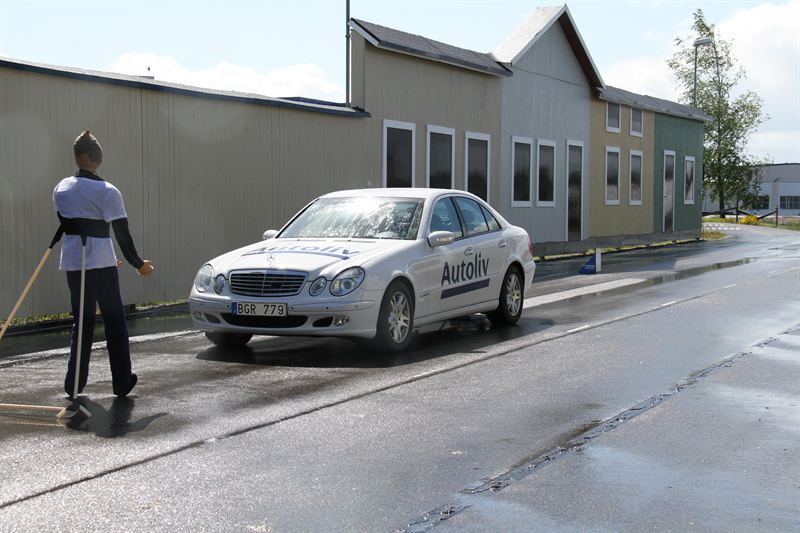Torricelli brake reduces stopping distance by up to 40%

- Autoliv showcases future safety solution for urban environments
(Stockholm, Sweden, June 11, 2015) – – – Autoliv, Inc. (NYSE: ALV and SSE: ALIVsdb), is showcasing a totally new vacuum braking system – the Torricelli brake – developed for significantly reducing stopping distance for Autonomous Emergency Braking (AEB). Autoliv states the innovation could revolutionize traffic safety in urban environments.
Tests have proven the so-called Torricelli brake – a vacuum induced plate below a vehicle which sucks down into the track during emergency braking situation – decreases braking distances with ~40 % in speeds up to 70 kph.
The technology, developed at Autoliv’s research plant in Vårgårda, Sweden., is named after 17th century Italian physicist Evangelista Torricelli, known for clinically accounting the vacuum and for inventing the barometer.
Many car accidents are caused by late braking with insufficient force. A driver may brake too late for several reasons: He or she is distracted or inattentive; visibility is poor or a pedestrian crosses the street without paying attention. Therefore, several car manufacturers today offer Autonomous Emergency Braking (AEB) systems. Autoliv’s revolutionary Torricelli Brake will radically enhance the efficiency of AEB systems by dramatically reducing the braking distances.
Technically, the Torricelli brake is connected to the automatic breaking system, which in turn is rigged to detect hazards ahead. The patented solution uses a 0.3 m2 vacuum plate below the vehicle that activates in merely 0.1 sec and produces a downforce of 15 000 N – independently from the tire-to-track friction.
This reduces stopping distances with up to ~40% on wet and dry asphalt, as well as ice surfaces.
Autoliv has put a maximum speed limit for activating the system at 70 kph, due to the effectiveness and force of the system. This in turn means that the Torricelli brake will mainly be applicable in urban environments, where for instance inattentive children and cyclists could be avoided.
“Even if there are several steps ahead before the Torricelli brake can be put into full-scale production, this is undoubtedly an example of how future innovations can revolutionize traffic safety and save more lives, in particular in urban environments,” says Ola Boström, head of Autoliv Research.
“The main hindrance for car manufacturer implementation of the Torricelli brake is simply that it is too efficient. In order to complement existing safety equipment, other safety details such as belt tighteners also need to be updated – due to the major braking force of the Torricelli brake system”, add Ola.
“I don´t want to speculate on whether the industry is ready to embrace the Torricelli brake, but so far we have showcased the system for a small number of manufacturers and we have gained substantial interest with this latest innovation. A reason pointing towards a short term, rather than long term, industry adaption is that car manufacturers today increasingly compete and gain market share based on the qualities of their safety systems,” Ola finishes.
Inquiries:
Thomas Jönsson, Group Vice President Communications. Tel +46 (0)8 58 72 06 27
Ola Boström, Senior Director Autoliv Research. Tel +46 (0)733 61 43 42
About Autoliv
Autoliv, Inc., the worldwide leader in automotive safety systems, develops and manufactures automotive safety systems for all major automotive manufacturers in the world. Together with its joint ventures, Autoliv has more than 80 facilities with more than 60,000 employees in 28 countries. In addition, the Company has ten technical centers in nine countries around the world, with 21 test tracks, more than any other automotive safety supplier.Sales in 2014 amounted to US $9.2 billion. The Company's shares are listed on the New York Stock Exchange (NYSE: ALV) and its Swedish Depository Receipts on the OMX Nordic Exchange in Stockholm (ALIV sdb). For more information about Autoliv, please visit our company website at www.autoliv.com.
Safe Harbor Statement
This report contains statements that are not historical facts but rather forward-looking statements within the meaning of the Private Securities Litigation Reform Act of 1995. Such forward-looking statements include those that address activities, events or developments that Autoliv, Inc. or its management believes or anticipates may occur in the future. All forward-looking statements are based upon our current expectations, various assumptions and data available from third parties. Our expectations and assumptions are expressed in good faith and we believe there is a reasonable basis for them. However, there can be no assurance that such forward-looking statements will materialize or prove to be correct as forward-looking statements are inherently subject to known and unknown risks, uncertainties and other factors which may cause actual future results, performance or achievements to differ materially from the future results, performance or achievements expressed in or implied by such forward-looking statements. Numerous risks, uncertainties and other factors may cause actual results to differ materially from those set out in the forward-looking statements. The Company undertakes no obligation to update publicly or revise any forward-looking statements in light of new information or future events. For any forward-looking statements contained in this or any other document, we claim the protection of the safe harbor for forward-looking statements contained in the Private Securities Litigation Reform Act of 1995, and we assume no obligation to update any such statement.





